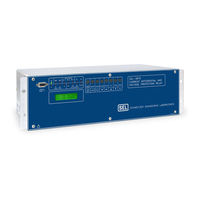Schweitzer Engineering Laboratories SEL-387E Manuals
Manuals and User Guides for Schweitzer Engineering Laboratories SEL-387E. We have 1 Schweitzer Engineering Laboratories SEL-387E manual available for free PDF download: Instruction Manual
Schweitzer Engineering Laboratories SEL-387E Instruction Manual (578 pages)
Current Differential and Voltage Protection Relay
Brand: Schweitzer Engineering Laboratories
|
Category: Relays
|
Size: 9 MB
Table of Contents
-
-
-
-
General11
-
-
-
-
-
Installation19
-
Panel Mount19
-
Rack Mount19
-
Connections23
-
Frame Ground28
-
Main Board35
-
Board Layout38
-
-
-
-
-
-
Blocking54
-
-
-
Current TAP70
-
Introduction49
-
-
-
-
-
-
Recommendations112
-
When 24CCS = DD113
-
When 24CCS = I114
-
When 24CCS = ID114
-
When 24CCS = U115
-
-
-
Control Logic121
-
-
Sel Ogic128
-
Output Contacts131
-
-
-
Trip Logic137
-
Close Logic140
-
-
Relay Word Bits146
-
-
-
Introduction173
-
-
Breaker Monitor182
-
Status Monitor192
-
-
-
Introduction199
-
Settings199
-
-
Breaker Monitor204
-
Settings Sheets214
-
-
-
Communications275
-
-
Indicators275
-
Cables275
-
Overview275
-
-
-
-
FTP Server283
-
Iec 61850284
-
Ping Server284
-
Telnet Server284
-
-
-
-
Access Levels288
-
Access Level 0288
-
Access Level 1289
-
Access Level 2289
-
-
Command Summary290
-
Alarm Conditions317
-
-
-
-
Time-Out325
-
Password Access326
-
Target Leds326
-
-
Meter327
-
Voltage (V)328
-
Energy (ENG)329
-
Frequency (F)329
-
Power (PWR)329
-
Status329
-
Bkr330
-
Date330
-
Other330
-
Lcd331
-
Reset51331
-
Set332
-
Tar332
-
Time332
-
Group333
-
Password334
-
Cntrl335
-
Port335
-
Local Bits336
-
Group340
-
-
Pushbuttons327
-
-
-
Analyzing Events353
-
Introduction353
-
-
-
-
Introduction381
-
-
Initial Checkout384
-
Power Supply385
-
Outputs387
-
Inputs387
-
Metering388
-
Current Metering388
-
Voltage Metering390
-
-
Differential401
-
-
-
-
-
Overview451
-
Boot458
-
Start SEL BOOT458
-
-
(Lmd477
-
Settings477
-
Operation477
-
Operate Commands479
-
-
-
-
Introduction479
-
Message Lists479
-
-
DNA Command488
-
ID Command488
-
BNA Command489
-
SNS Message489
-
-
-
Introduction491
-
CBREAKER Command494
-
CEVENT Command495
-
CHISTORY Command497
-
CSTATUS Command498
-
CTARGET Command499
-
-
-
Introduction501
-
-
-
Overview507
-
Configuration507
-
Device Profile509
-
Object Table512
-
Data Map516
-
Point Remapping523
-
Inputs523
-
Introduction523
-
Modem Support525
-
Virtual Terminal526
-
-
-
-
Features529
-
-
Object Models531
-
Data Mapping532
-
File Services533
-
Goose533
-
Mms533
-
SCL Files533
-
Reports534
-
Datasets536
-
GOOSE Processing537
-
Advertisement
Advertisement
Related Products
- Schweitzer Engineering Laboratories SEL-387-0
- Schweitzer Engineering Laboratories SEL-387-5
- Schweitzer Engineering Laboratories SEL-387-6
- Schweitzer Engineering Laboratories SEL-321-5
- Schweitzer Engineering Laboratories SEL-321-2
- Schweitzer Engineering Laboratories SEL-321
- Schweitzer Engineering Laboratories SEL-351S
- Schweitzer Engineering Laboratories SEL-351-3
- Schweitzer Engineering Laboratories SEL-351-5
- Schweitzer Engineering Laboratories SEL-351-7
